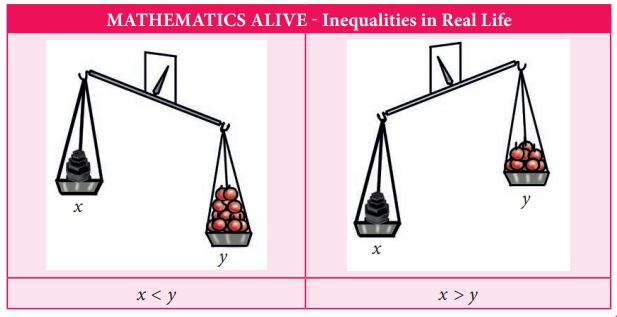Introduction to Identities | Term 3 Chapter 3 | 7th Maths - Algebra | 7th Maths : Term 3 Unit 3 : Algebra
Chapter: 7th Maths : Term 3 Unit 3 : Algebra
Algebra
Chapter 3
ALGEBRA

Learning Objectives
â To understand the following identities
through geometrical proof
*
(x +
a )(x +b) = x 2 +
x(a + b) +ab
*
(a +
b)2 =a2 + 2ab +b2
*
(a â
b)2 = a2 â 2ab +b2 and
*
(a +
b)(a âb) = a 2 âb2 .
â Able to apply the identities in numerical
problems.
â Able to recognise expressions that
are factorisable.
â To represent inequalities in one variable,
graphically.
Introduction to Identities
In earlier classes, we have learnt to
construct algebraic expressions using exponential notations. For example, x
2 + 3x +2 is an algebraic expression in the variable
x. This can also be written as an equation x2 +
3x = â2 .
By substituting numerical values for
x, we can verify this equation.
If x
= â2
, then
L.H.S = x 2 +
3x = (â 2)2 +3(â
2)
= 4 â 6
= â2 = R.H.S
Hence, this equation is true when x
= â2.
If x = â1
, then
L.H.S = x2 +
3x = (â 1)2 +3(â1)
=1 â3
â2 = R.H.S
Hence, this equation is true when x
= â1.
But when
x = 1 , then L.H.S = x2 +
3x = (1)2 +3(1)
= 1 +3
= 4 â R.H.S
Thus, this equation is not true when
x = 1 .
Thus, x2+ 3x = â2
is an equation which is true only when x takes the values â1 and â2. Hence,
an equation is true only for certain values of the variable in it.
It is not true for all values of the
variables.
Now, consider the algebraic expression,
(a + b)2 = a2 +
2ab +b2 . Let us try to find the values of the
expression for the given values of a and b.
When a =
3 and b = 5,
L.H.S = (a +
b)2 =(3 + 5)2 =82
=
8 Ã
8 =64
R.H.S = a 2 +
2ab +b2 = 32 +(2Ã
3 Ã5)
+
52 =9 + 30 +25 = 64
Thus, for a =
3 and=
b = 5 , L=.H.S = R.H.S
Similarly,
when a = 4 and b = 7,
L.H.S = (a +
b)2 =(4 + 7)2 =112
=121
R.H.S = a 2 +
2ab +b2 = 4 2 + (2Ã
4 Ã7)
+
72 = 16 + 56 +49 =121
Also, for a =
4 and b = 7 , L.H.S = R.H.S
Thus, we shall find that for any value
of âaâ and âbâ L.H.S = R.H.S. Such an equality, which is true for every value of
the variable in it is called an identity. Thus, we observe that the equation (a
+
b)2 =a2 + 2ab +b2 is an identity.
In general, algebraic equalities which
hold true for all the values of the variables are called Identities. Let us see the basic identities with
geometrical proof.
MATHEMATICS ALIVE- Inequalities in Real Life

Related Topics